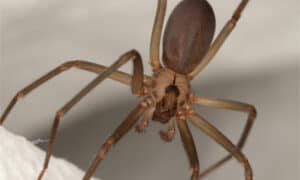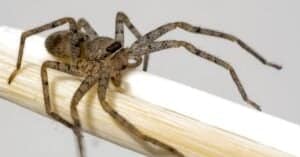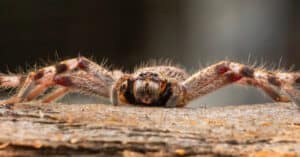Connecticut, the southernmost state in New England, is home to a rich and varied ecosystem that spans from the rolling hills of Litchfield County to the sandy beaches of Long Island Sound. Yet, amidst the state’s natural splendor lies a hidden menace: brown spiders.
For some, the mere mention of spiders may send chills down their spine. Conversely, others may marvel at their unique adaptations and survival strategies. Regardless of where you fall on the spectrum, the presence of brown spiders in Connecticut will leave you intrigued and perhaps a bit cautious as you explore the state’s wilderness.
1. Humpbacked Orbweaver (Eustala anastera)
Connecticut is home to an intriguing species of spider known as Eustala anastera. These fascinating arachnids are part of the orbweaver family.
The humpbacked orbweaver is a distinctive arachnid. Its elongated abdomen is more extended than its width, featuring a pronounced hump on its dorsal side. While its coloration and markings can vary, this spider is typically a dark brown to reddish-brown hue, with some specimens sporting dark folium or spots on their abdomens. The cephalothorax is covered in light hairs, giving it a furry appearance.
Females of this species measure between 3/16″ to 3/8″ in length, with a leg span ranging from 3/8″ to 3/4″. Conversely, males are slightly smaller, with a body length of 1/8″ to 3/8″.
The humpbacked orbweaver, much like other spiders in its family, is known for creating an intricate web that can span up to six feet in height from the ground. These elaborate webs are typically in the form of an orb, with the spider positioned at the center, waiting for unsuspecting prey to become trapped.
This species can be found in open woodlands and at the edges of forests, often residing on trees and shrubs. During the daytime, it rests on dead twigs or branches, taking advantage of its coloring and markings to blend in with its surroundings and avoid detection.
As adept predators, humpbacked orbweavers serve as highly effective pest controllers. They prey on various small insects, including moths, flies, beetles, mosquitoes, and wasps, which make up a significant portion of their diet.
At first glance, these spiders may appear quite formidable. However, it’s worth noting that despite their intimidating appearance, humpbacked orbweavers do not possess venom potent enough to cause harm to humans or our pets.
Fun Facts
- These spiders, like many other members of their family, have multiple eyes but poor eyesight.
- They tend to build or repair their webs during the nighttime hours.
- Homeowners typically notice these spiders more frequently during late summer and fall when they become more active.
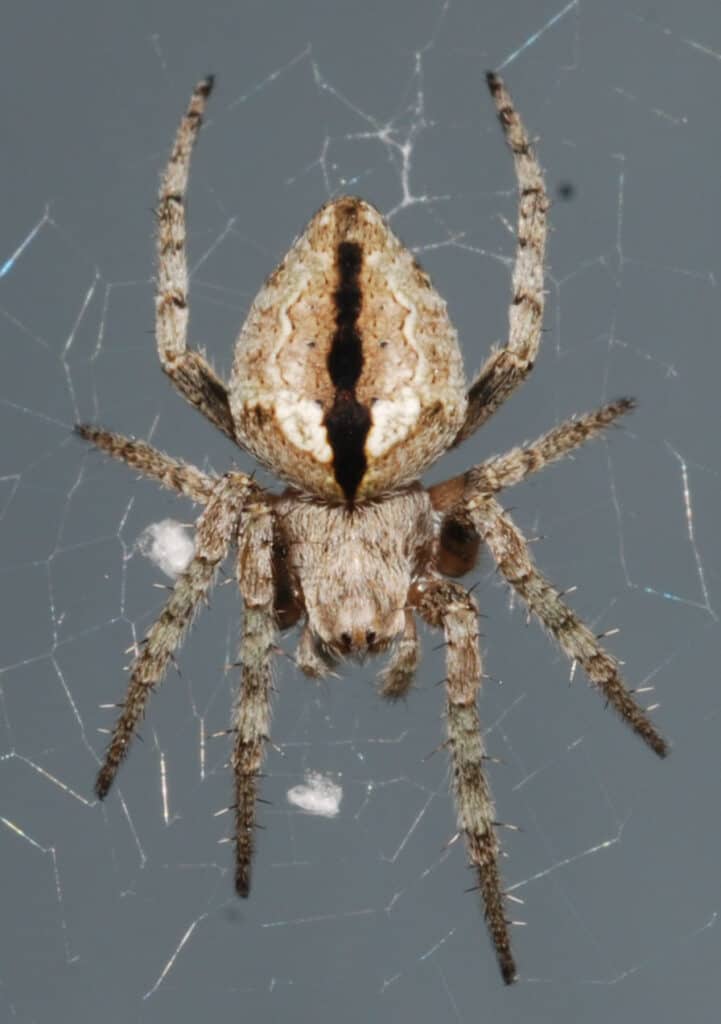
The humpbacked orbweaver possesses a distinctive hump near the rear of the abdomen. It is one of the most impressive brown spiders in Connecticut.
©Smithsonian Environmental Research Center / Creative Commons – License
2. False Widow (Steatoda nobilis)
The false widow spider shares a resemblance with the black widow spider, leading to confusion among residents in Connecticut.
The body of the false widow spider has a glossy, chocolate-brown appearance, and sometimes it can appear reddish-brown. Unlike the black widow, this spider lacks the distinctive red hourglass marking on its abdomen, instead having unique cream-colored markings. However, both the false widow and the black widow share a similar rounded and bulbous abdomen.
On average, female false widow spiders measure between 0.27 and 0.6 inches in length, while males are typically smaller, ranging from 0.16 to 0.27 inches in length.
The false widow spider is predominantly a nocturnal creature. During the day, it can often be found hiding in deep cracks or holes adjacent to its web.
False widow spiders tend to favor dry and relatively warm environments where they are less likely to be disturbed. As a result, they often end up indoors and can frequently be spotted in sheds or outbuildings.
As carnivorous creatures, false widow spiders primarily feed on flying insects but also on other spiders, including black widows.
Generally, the symptoms of a false widow spider bite are not more severe than a bee or wasp sting. However, a few individuals have reported experiencing more acute symptoms, such as swelling, throbbing pain, and tingling in the fingers after being bitten by this spider.
Fun Facts
- False widows are not as dangerous as commonly believed.
- They will not exhibit aggressive behavior by running or jumping at humans.
- False widow spiders are generally timid and scared of humans, just as humans may be afraid of them.
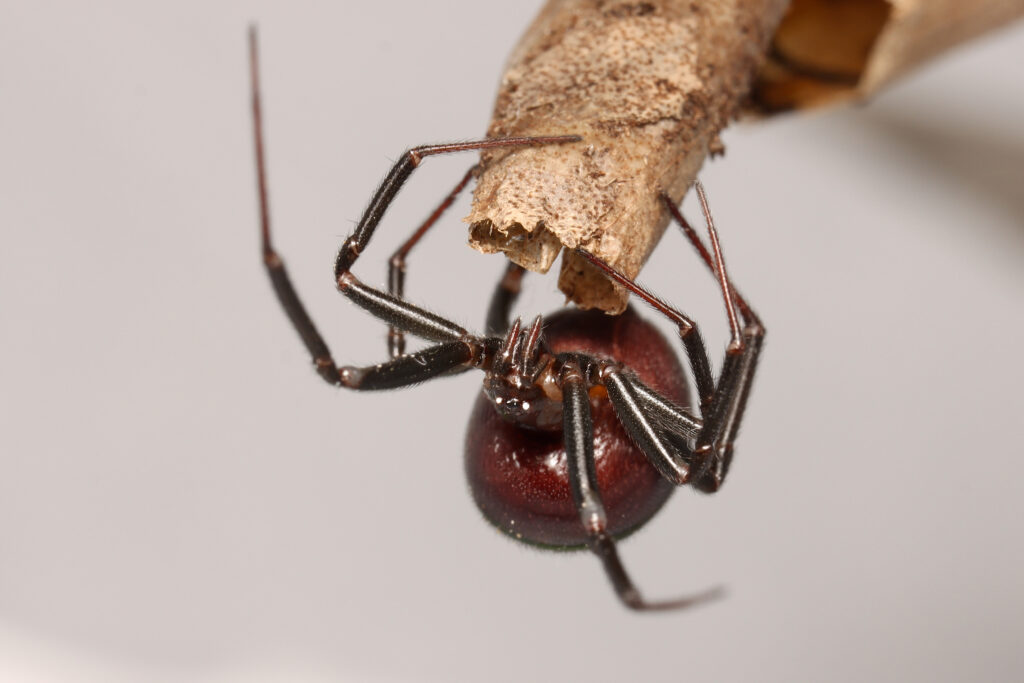
The false widow is one of the most common brown spiders in Connecticut. It has a glossy, chocolate-brown appearance, and it is not as dangerous as believed.
©Dan Olsen/Shutterstock.com
3. Barn Funnel Weaver (Tegenaria domestica)
Tegenaria domestica is a type of spider that belongs to the Agelenidae family of funnel-web spiders. It is known as the barn funnel weaver in Connecticut and the domestic house spider in various parts of Europe.
Barn funnel weaver displays a distinct coloration of dark brown or reddish brown with light patches and occasional dark bands on the abdomen. In addition, the shape of the abdomen sets it apart from other types of funnel weavers commonly found indoors, as it is blunt instead of elongated.
Female spiders typically measure between 0.3 to 0.45 inches in length, while males range from 0.23 to 0.35 inches.
Barn funnel weavers are skilled hunters. They use both their vision and quick movements in combination with web mechanisms to catch prey. They have six forward-facing eyes out of a total of eight, which helps them detect movement and focus on their potential food source. These spiders are also known for their photosensitivity, meaning they will either move toward or away from light, depending on the situation.
They are commonly found living in and around buildings as well as in outdoor habitats like hollowed-out trees and caves. Barn funnel weaver spiders have a diverse diet, including different insect types, making them effective pest controllers.
Barn funnel weavers pose no threat to humans as they are not venomous and rarely bite. Even if they do bite, the bite is not likely to pierce the skin.
Fun Facts
- Spiderlings of the barn funnel weaver look like miniature versions of the adults and undergo molting as they grow.
- When hunting, barn funnel weavers quickly rush out to attack their prey and then drag it back to the back of their funnel web to consume their meal.
- These spiders are fast runners and tend to be shy in nature.
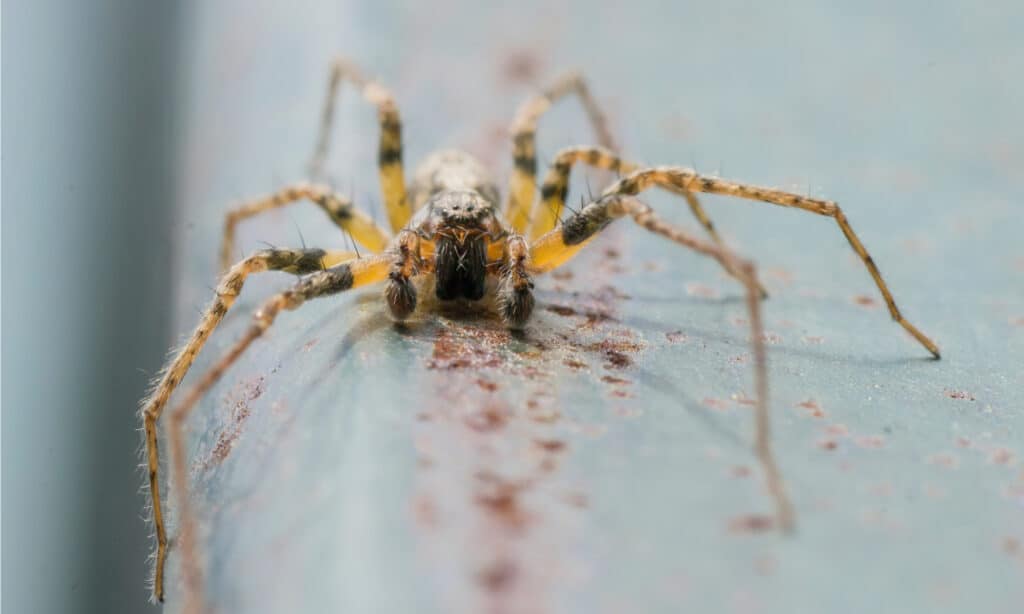
Barn funnel weaver displays a distinct coloration of dark brown or reddish brown with light patches and occasional dark bands on the abdomen.
©Korovko Gleb/Shutterstock.com
4. Triangulate Cobweb Spider (Steatoda triangulosa)
Among the brown spiders in Connecticut, there is also the triangulate cobweb spider. It is thought to have its roots in Eurasia and was introduced to Connecticut and other parts of the United States.
The triangulate cobweb spider is a small spider with a length ranging from 0.13 to 0.25 inches. Their cephalothorax is typically brown-orange, and their abdomen has a triangular pattern, which is how they got their name. The spider’s legs are usually yellowish in color.
Triangulate cobweb spiders spend considerable time developing their webs, which can withstand quite a bit of pressure if constructed correctly. In addition, they spend a portion of their day feeding and may have a collection of deceased insects, such as stinkbugs, other spiders, and even wasps, either on their webs or underneath them.
Triangulate cobweb spiders are commonly found living in the wild, and they construct their webs in locations such as under tree bark, rock piles, or on the walls of houses.
They primarily feed on insects such as ants, spiders, pill bugs, and even ticks. Having an infestation of triangulate cobweb spiders can be advantageous as they consume other harmful spiders, like black widows, which can pose a threat to humans.
There have been no reported cases of illnesses resulting from the bite of the triangulate cobweb spider, and their bites are not known to be harmful to humans. Furthermore, they are not aggressive spiders and will typically retreat if they feel threatened.
Fun Facts
- Triangulate cobweb spiders are most commonly spotted in homes during March and April.
- They have poor eyesight and depend on web vibrations to detect prey.
- While the bite of a triangulate cobweb spider is not lethal, an allergic reaction may occur.
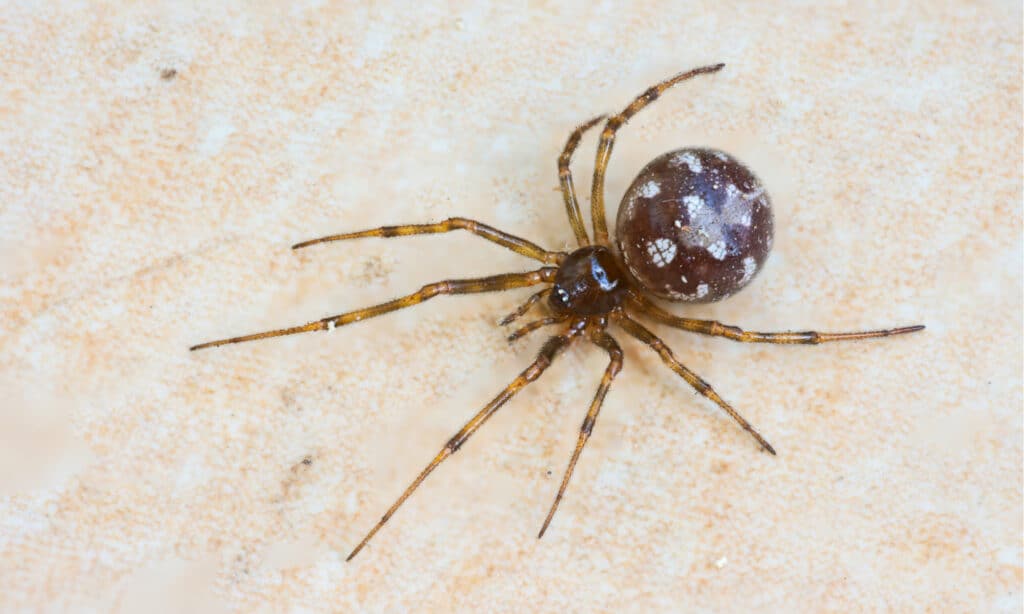
The triangulate cobweb spider is a small brown spider in Connecticut.
©Timelynx/Shutterstock.com
5. Striped Fishing Spider (Dolomedes scriptus)
The striped fishing spider has variable markings and coloring, typically brown, tan, or gray. Certain specimens may have a distinct white or tan stripe running along the sides of their body. The abdomen features an intricate pattern of dark and white W-shaped marks, giving it a sculpted appearance. Females can grow up to an inch in length, while males are smaller.
Using vibrations on the water’s surface to detect prey, the striped fishing spider is capable of skating across the water and subduing its target. This spider species is adept at capturing small fish and other aquatic creatures, even capable of diving underwater like many other fishing spiders.
The striped fishing spider can live near various bodies of water, such as streams, particularly in fast-flowing streams. However, this spider species can inhabit a wide range of aquatic environments.
Fishing spiders can consume prey that can be almost five times their size. These spiders have been known to eat a variety of aquatic creatures, including, but not limited to, aquatic insects, frogs, tadpoles, and even small fish.
Fun Facts
- Striped fishing spiders do not spin webs.
- Predators of striped fishing spiders include snakes, wasps, birds, and dragonflies.
- The lifespan of these spiders is approximately one year.
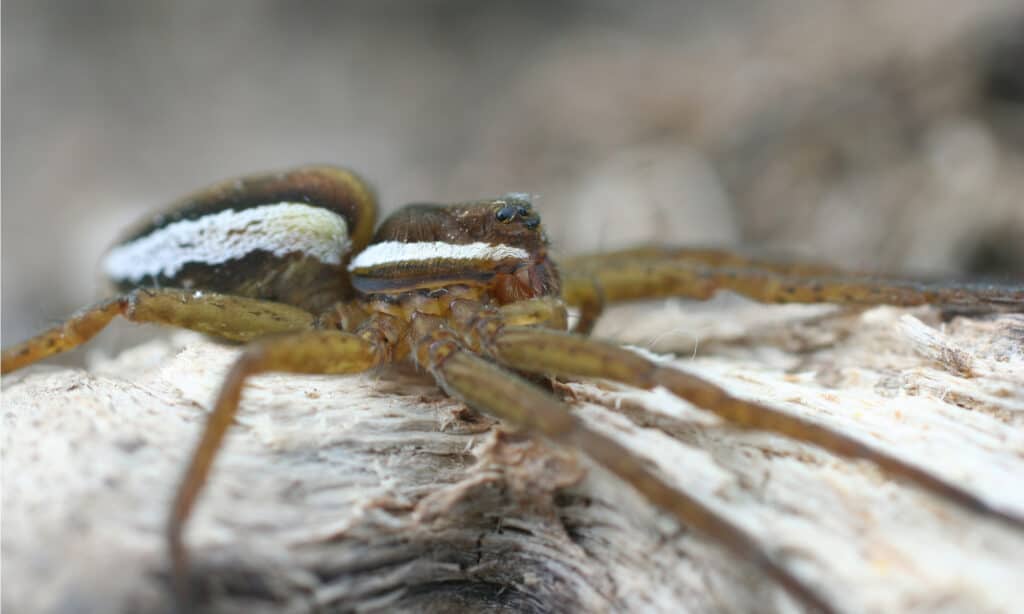
Using vibrations on the water’s surface to detect prey, the striped fishing spider is capable of skating across the water and subduing its target.
©Oleg Nikonov/Shutterstock.com
6. Brown Recluse (Loxosceles reclusa)
Connecticut is home to the notorious brown recluse spider, one of the most venomous spider species in the state.
This spider is also known as the fiddleback or violin spider due to the distinct, dark violin-shaped marking on its front body section or cephalothorax. Interestingly, the neck of the violin points towards the rear. Unlike most spiders, the brown recluse has only six eyes instead of the usual eight.
These spiders have a body size ranging from about the size of a dime, nearly 1/4 inch, to the size of a quarter, approximately 1/2 inch, and come in shades of tan to dark brown. Even though spiderlings look similar to adults in structure, they are lighter in color.
The brown recluse spider is notorious for cannibalism, as they are known to consume their own kind. Unlike other species that utilize webs to capture their prey, these spiders are active nocturnal predators. Rather than trapping their victims, brown recluse spiders hunt and chase down their prey.
Preferring secluded and arid locations, these spiders seek shelter in dimly lit and undisturbed areas. As a result, they are commonly found indoors in cardboard boxes, storage closets, laundry left on the floor, and basements. Outdoors, they tend to inhabit garages, sheds, and woodpiles.
The brown recluse spider sustains itself by feeding on a diet primarily consisting of insects, including flies, crickets, moths, and cockroaches.
Although there is significant media coverage and public fear about brown recluse spiders, their bites are generally not fatal. However, their venom can cause extensive tissue damage, resulting in an ulcerated sore up to several inches in diameter that can take 6-8 weeks to heal. Despite this, there has never been a confirmed case of death resulting from a brown recluse spider bite in North America.
Fun Facts
- Like most other spider species, the brown recluse spider can survive for extended periods without food or water.
- Brown recluse spiders only tend to bite humans when provoked.
- Treatment for brown recluse spider bites typically does not require medication.
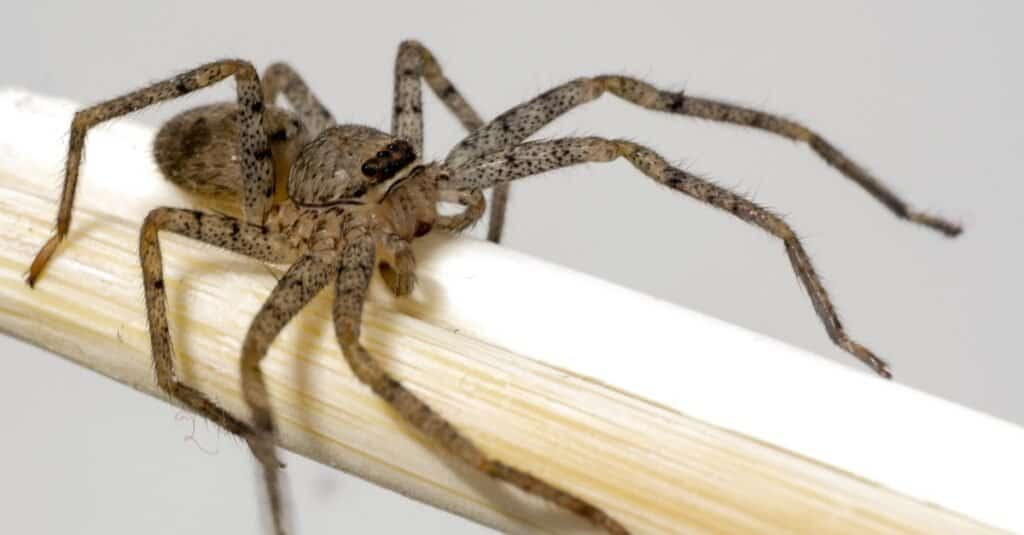
The brown recluse is the most dangerous of all brown spiders in Connecticut.
©Physics_joe/Shutterstock.com
The photo featured at the top of this post is © Danie Spreeth Photography/Shutterstock.com
Thank you for reading! Have some feedback for us? Contact the AZ Animals editorial team.



